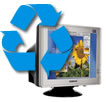In the wake of the nation-wide switch to digital television, are you wondering what to do with your old analog TV sets? Recycling them is easier than you think – and better for the planet, too.
Trashing televisions adds to the mountains of garbage people throw away every day. Plus, tossing your tv releases toxic chemicals into the environment. On average, a television contains four to six pounds of lead, plus mercury and cadmium – all dangerous heavy metals that can pollute our drinking water if they get loose (as they inevitably will if they’re just thrown into a landfill).
What’s the alternative?
* Convert it. If your set is still in good working order, get a converter box so you can switch the set to digital cable. Until July 31, 2009, you can redeem a free government coupon worth $40 to help underwrite the cost of the converter box.
* Recycle it. Check locally to see if your state has established e-waste recycling centers. For example, Washington state has had 200 collection points open since January that collect old televisions, computers, and monitors for free. Maine and Oregon have similar programs and many other states will soon. TIA E-Cycling Center lists municipal and private drop-off locations by state.
* Give it back. The manufacturer or retailer of your television set may reclaim and recycle it. The U.S. EPA has created a partnership called Plug-in to eCycling which lists companies that recycle old electronics. Sony, Sharp, Best Buy, Panasonic, and Wal-Mart are among the participating companies. Check out their website to see if the retailer or manufacturer who sold you your TV is on the list.
Earth911 links to more local television recycling options.
The EPA estimates that 99.1 million television sets sit in homes, unused, across the US. If you consider that each one contains 5 pounds of lead on average, that’s nearly 500 million pounds of lead that could potentially end up in the environment. No wonder trashing your tv is now illegal in many municipalities.
by Katie Kelleher















2 thoughts on “TV Recycling? Here’s How”
I have an old TV and a digital cable box – my TV works just fine. I’ll be hanging on to it as long as I can convince my husband to!
I’ve also heard that people with antennas can now receive more channels better with the new signal, but I haven’t tried it.
There are a lot of organizations that promote environmentally safe practices. One way people can contribute is to mange their paper waste and e-waste. Businesses that manage and dispose of documents and records include paper shredding companies and document destruction businesses. As a Texas shredding company, we assist corporate entities in managing and disposing their paper waste and get them ready for recycling.
Comments are closed.